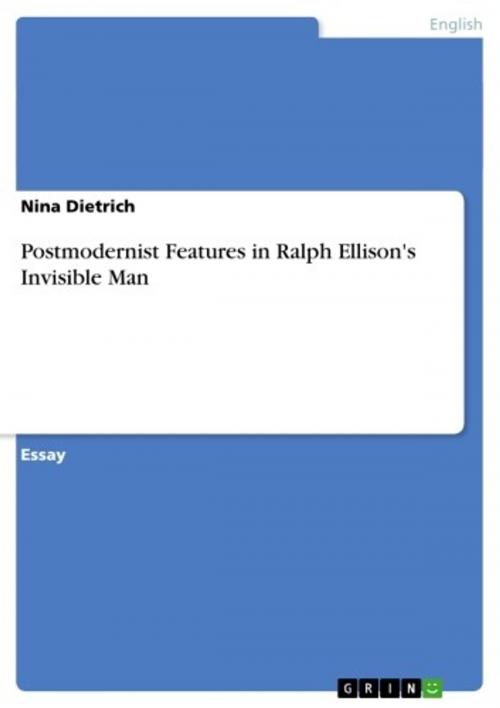Postmodernist Features in Ralph Ellison's Invisible Man
Nonfiction, Entertainment, Drama, Anthologies| Author: | Nina Dietrich | ISBN: | 9783638239868 |
| Publisher: | GRIN Verlag | Publication: | December 17, 2003 |
| Imprint: | GRIN Verlag | Language: | English |
| Author: | Nina Dietrich |
| ISBN: | 9783638239868 |
| Publisher: | GRIN Verlag |
| Publication: | December 17, 2003 |
| Imprint: | GRIN Verlag |
| Language: | English |
Essay from the year 2003 in the subject American Studies - Literature, grade: 1.0, University of Kent (School of English), course: American Modernisms, 16 entries in the bibliography, language: English, abstract: In an attempt to place Ralph Waldo Ellison's novel Invisible Man within a Modernist framework, Berndt Ostendorf writes, 'Ellison ... is a 'Spätling,' a latecomer to Modernism. ... Ellison's Modernism ... is not one of crisis and despair, but of innovation and hope. He accepts the discipline implied in [Ezra Pound's] slogan 'make it new,' but rejects the cultural pessimism of his ancestors.'1 Although Ostendorf's description is right insofar that Ellison's work is optimistic in its outcome rather than as pessimistic as the majority of modernist novels, it does not seem to be in agreement with the term Modernism in general. Isn't modernist literature usually called a 'literature of ... crisis'?2 Isn't Modernism said to feature 'elements of cultural apocalypse' rather than the hope Ostendorf mentions?3 And: Doesn't Ostendorf's statement resemble a definition of Postmodernism rather than Modernism? In fact, Ellison's novel is hard to categorize. Critics agree that Invisible Man includes characteristics of different literary periods. Malcolm Bradbury, for instance, says the novel mixes 'naturalism, expressionism, and surrealism' and thereby places it somewhere between Modernism and Postmodernism.4 As these two terms are problematic as far as their definitions are concerned, this essay will begin by naming some of the key characteristics of both periods. Later on, the essay will point out a number of typically postmodern features that Ellison integrates into Invisible Man and give examples from the novel itself. Eventually, the essay will discuss whether Invisible Man should be considered a modernist or postmodernist novel. 1 Berndt Ostendorf, 'Anthropology, Modernism, and Jazz', in Harold Bloom, Ralph Ellison, Chelsea House Publishers, 1986, pp. 161 - 164 2 Peter Childs, Modernism, Routledge, 2000, p.14 3 Malcolm Bradbury in A Dictionary of Modern Critical Terms, ed. Roger Fowler, as quotes in Childs, Op. Cit., p. 2 4 Malcolm Bradbury, The Modern American Novel, 2nd edition, Oxford University Press, 1992, p. 166
Essay from the year 2003 in the subject American Studies - Literature, grade: 1.0, University of Kent (School of English), course: American Modernisms, 16 entries in the bibliography, language: English, abstract: In an attempt to place Ralph Waldo Ellison's novel Invisible Man within a Modernist framework, Berndt Ostendorf writes, 'Ellison ... is a 'Spätling,' a latecomer to Modernism. ... Ellison's Modernism ... is not one of crisis and despair, but of innovation and hope. He accepts the discipline implied in [Ezra Pound's] slogan 'make it new,' but rejects the cultural pessimism of his ancestors.'1 Although Ostendorf's description is right insofar that Ellison's work is optimistic in its outcome rather than as pessimistic as the majority of modernist novels, it does not seem to be in agreement with the term Modernism in general. Isn't modernist literature usually called a 'literature of ... crisis'?2 Isn't Modernism said to feature 'elements of cultural apocalypse' rather than the hope Ostendorf mentions?3 And: Doesn't Ostendorf's statement resemble a definition of Postmodernism rather than Modernism? In fact, Ellison's novel is hard to categorize. Critics agree that Invisible Man includes characteristics of different literary periods. Malcolm Bradbury, for instance, says the novel mixes 'naturalism, expressionism, and surrealism' and thereby places it somewhere between Modernism and Postmodernism.4 As these two terms are problematic as far as their definitions are concerned, this essay will begin by naming some of the key characteristics of both periods. Later on, the essay will point out a number of typically postmodern features that Ellison integrates into Invisible Man and give examples from the novel itself. Eventually, the essay will discuss whether Invisible Man should be considered a modernist or postmodernist novel. 1 Berndt Ostendorf, 'Anthropology, Modernism, and Jazz', in Harold Bloom, Ralph Ellison, Chelsea House Publishers, 1986, pp. 161 - 164 2 Peter Childs, Modernism, Routledge, 2000, p.14 3 Malcolm Bradbury in A Dictionary of Modern Critical Terms, ed. Roger Fowler, as quotes in Childs, Op. Cit., p. 2 4 Malcolm Bradbury, The Modern American Novel, 2nd edition, Oxford University Press, 1992, p. 166















